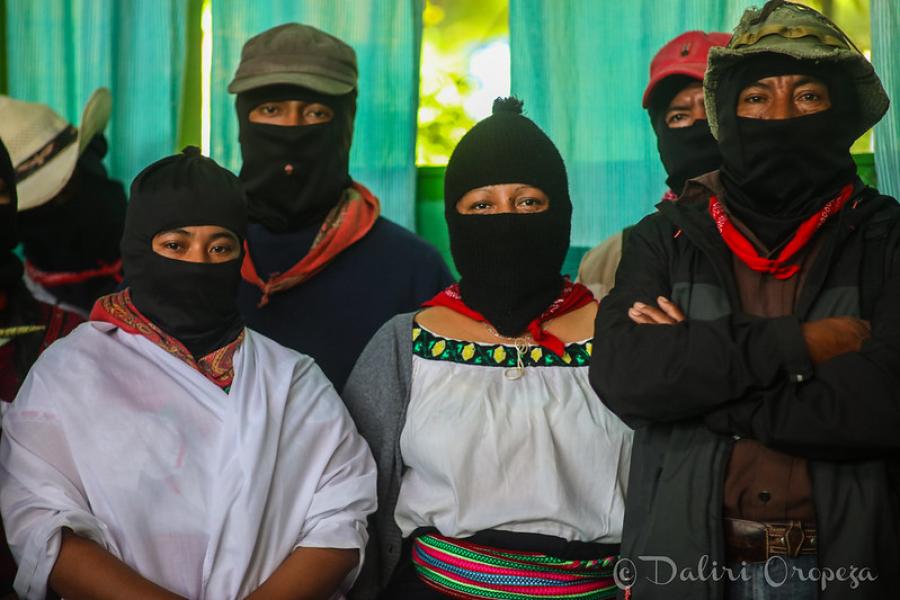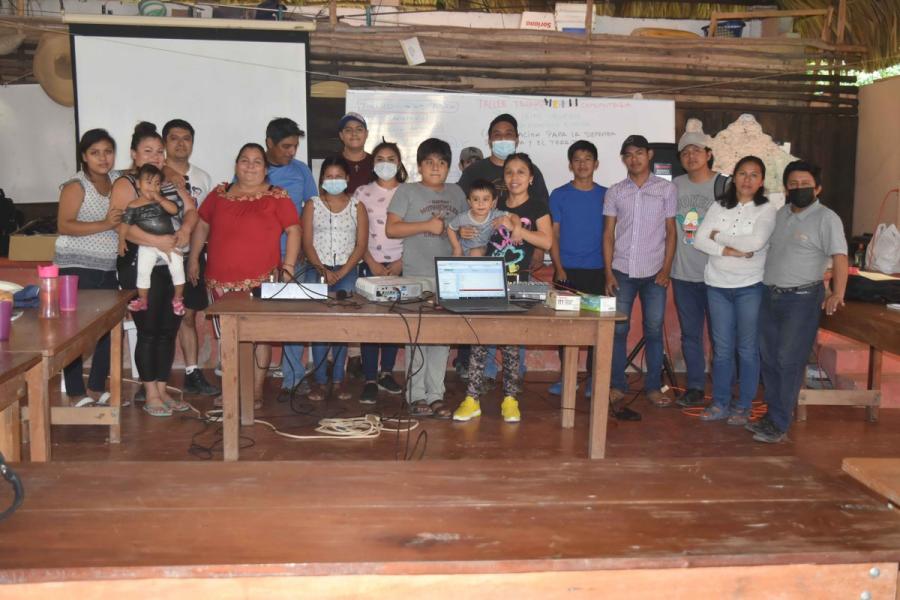For better or worse, the integrating winds of "modernity" can't be kept out of most of the indigenous, communal world that still exists in the remote mountains of Oaxaca, Mexico. Nor do communities here necessarily want them kept out. On the contrary, Oaxacan indigenous communities often seek out the urban-industrial society.
Clearly, however, this meeting holds great risk for indigenous peoples. Only with great difficulty can they avoid being transformed in unexpected directions. Moreover, their capacity to resist unwanted change comes from collective structures that must themselves constantly adapt to new elements.
In this context, a number of Zapotec communities in Oaxaca decided to band together in the last decade to manage local forests. After a long process of struggle to control their natural resources, the efforts bore fruit at two levels. Locally, community forestry enterprises (CFEs) enable people to both profit from and care for the forests. On a wider scale, the Union of Forest Ejidos and Communities of Oaxaca (UCEFO) offers technical services in forest management to 10 member communities. Together, UCEFO and the CEFs have molded a distinctive relation between communal tradition and urban-industrial production.
A RESPONSE TO EXPLOITATION
The formation of the CFEs and UCEFO arose from abuses perpetrated by timber companies beginning at least a half century ago. From the 1940s to the present, the Mexican government's approach to rural development has encouraged industrialization based on food production and cheap raw materials. This model has drained the financial resources of peasants and indigenous peoples, limiting their captialization and leading them to migrate from their homes in search of jobs.
In forestry, this process dates from 1947, when Mexico revised its forestry laws. This "reform" legalized vast and concessions to timber companies and tied timber production to the goal of industrialization. To bypass the fact that 70 percent of Mexican forests were on ejido (community) land - and thu not subject to sale or lien - the law let companies, in effect, "rent" forests for as long as 30 years.
The 1947 law led to the growth of both private and quasi-state timber companies in Oaxaca and elsewhere, while generating few local benefits. At best, some roads were built and a few individuals got jobs as lumberjacks or in road construction, but usually communities were left with unfilled contractual commitments to buy timber. As one peasant noted:
In the Sierra Sur Mountains, the Oaxaca Forest Co. owned the woods. It did whatever it wanted to with the poor forest. The foresters would come to mark [the trees for cutting] and claim they were affected by disease. Then they cut them right down, carrying away the best wood. They built the roads in the most accessible areas and left the hills completely bald.
In reaction to this abuse of communal resources, unrest arose in 1964 when the people of Santiago Textitlan carried out a work stoppage against the Oaxaca Forestry Co. From that year on, strikes and road blocks - and the repression of communal leaders - became regular features of Oaxacan forest management.
This ferment boiled over in 1981 and 1982 as two 25-year concessions ended. When the government declared new concessions, despite organized opposition to any renewal, the Zapotec fought back. They used both civil disobedience - including blocking logging roads - and legal means to fight the concessions. After intense local protests and support from national organizations, the government suspended the decrees.
This victory became a precedent for peasant and indigenous struggles to control natural resources, although the subsequent stages have required even more effort. The communities had little experience in managing forests and less in managing forests and less in managing businesses. Yet to manage forest resources, they had to train individuals, reorganize local structures, and amass capital.
In 1983, the communities learned an important lesson as they negotiated with industry for their timber. Having defeated the government concession, the communities controlled the resource the industry needed to survive - and they didn't have to sell. Each community went about the negotiations deliberately and democratically. The general assembly of each community established guidelines for local forestry enterprises, giving birth to the first CFEs.
Beginning with small annual contracts for 400 to 650 cubic yards, each CFE risked little. And as communities took their time about entering the marketplace, timber companies offered between prices to those who were ready to sell in larger volume, pushing prices up considerably.
As prices rose, the communities slowly gathered capital, took on more of the management of their forests, and, in December 1985, organized UCEFO. This incorporation let them negotiate with the government for the right to administer their own forest services at less cost than contracting for them from the government. Moreover, through UCEFO the forest communities of Oaxaca set out to prove that it was possible to live from their greatest natural resource without abusing it.
THE COMMUNITY ENTERPRISES AND UCEFO
The 10 communities that form UCEFO are located in the rugged Sierra Norte and Sierra Sur mountains of Oaxaca, where the altitudes vary from 2,600 to 11,500 feet above sea level. Some 18,000 people live in these communities. It is a poor area, with high rates of illiteracy.
UCEFO's resources include 300,000 acres of forest, of which 65 percent is pine and pine-oak forest, 29 percent in shrub and secondary growth, and 6 percent is farm land. The authorized volume for the 1989-90 cutting cycle was 65 percent of a potential annual harvest of 400,000 cubic yards of timber. The CFEs produce a variety of forest products, including logs, cellulose, posts, pine boards, and charcoal.
In the early 1980s, the first CFE foresters in UCEFO learned to control and combat forest pests, and later gained experience in nursery and reforestation techniques. From that base, they gradually built up their ability to manage the forests, drawing on advice from Finnish silviculturists that the government of Mexico had invited to look into ways to manage forests as an integrated whole.
This advice laid the foundation for exploiting forests on a long-term sustainable basis. Thus, UCEFO's integral forest - management plans consider the development potential and ecological limitations of the land, as well as market necessities, the social and economic impacts of exploiting the forest, and the requirements in terms of organization, training, and investment.
As a result, UCEFO and the CFEs manage pine-oak forests according to a system of selective cutting to create even-aged stands. Care is also taken to protect watersheds and river channels, give threatened species special consideration, carry out fire and pest control, and reforest burned - over areas and abandoned farm land. The plan also gives attention to using all of a tree.
Although forestry is the key source of income, local economies are relatively diversified. For example, 90 percent of the people farm, with each family having two to five acres of corn, beans, squash, and potatoes - not enough for subsistence - as well as oats for fodder and vegetables and flowers to market. Over half the families own a few cattle, goats, or sheep, and 17 percent care for fruit groves. A tenth work outside their own community, which is quite low by Oaxacan standards.
While about 40 percent have permanent jobs in forestry in combination with farming, everyone benefits to some degree from investments made by the CFEs. Ten years after their founding, these communal enterprises control an impressive infrastructure, including tractors, backholes, trucks, and assorted office equipment. Five communities own sawmills. UCEFO, with 43 employees, has two industrial plants; one produces telephone poles, the other, charcoal.
The principal characteristic distinguishing UCEFO from other ejido unions is its emphasis on training - 80 percent of the directors, technicians, and operators are community members. At the national level, in 1988 UCEFO was among the first local organizations to win the right to administer their own forest technical services. These had been the preserve of the federal government.
Drawing on their own resources, the forest communities of Oaxaca have financed what governments denied them for decades. Besides jobs, the communities have built municipal offices, athletic courts, bridges, churches, meeting halls, houses for teachers, and schools. They have extended and improved roads and installed electricity and potable water. And they have won widespread recognition in Oaxaca, including from banks that consider them worthy of credit.
BUILDING ON TRADITION
The communities in UCEFO have adapted a traditional system to the demands of forest management and forest industries. Although the fit hasn't always been easy, the result has been to enhance the communal experience.
In the Zaptoec communities that compose UCEFO, adult men serve in a complex hierarchy of religious, civic-political, and agrarian posts. These posts are unpaid and obligatory for a man to have full rights. Election to each office is by a vote in the community general assembly, and to arrive at a high position, a man must pass through the lower ones. Under this system, each man learns the affairs of his community and, at the same time, shows his abilities, honor, and responsibility.
When the first CFEs were created, the workload and responsibilities overwhelmed the traditional unpaid authorities. It became necessary to devise more business-oriented mechanisms to take charge of forest production and marketing. The CFEs created their own structure and instituted paid leadership posts. Today, each CFE employs a coordinator, reorder, finance chief, and field chief. All posts are filled the old way - through election by the general assembly.
Other traditional mechanisms help the communities maintain control over common property. Each CFE has an oversight committee that conducts periodic internal audits, and its members, too, are elected in the general assembly. As is established by tradition, these positions rotate annually.
The commisariado (an elected official in charge of communal property), the CFE coordinator, and the chief of finances jointly manage all earnings from the forest. The general assembly decides how to distribute the profits. Similarly, the assembly authorizes regulations and the CFE's annual work plan.
A board of directors, composed of a president, secretary, and treasurer, manages UCEFO. These posts are elected by a 105-member Assembly of Representatives and rotate among member communities. The assembly, UCEFO's highest body, is made up of authorities from each community, the CFE coordinators, the community oversight committees, and delegates to UCEFO from each community.
As a second-level organization dedicated to technical services and training, UCEFO operates in two broad areas. First, it provides support to CFEs for forest management, including conducting forestry studies. In addition, it provides administrative and financial training to each set of new leaders, to the oversight committee, and to the delegates to UCEFO. Since the personnel rotation of CFEs and delegates is constant, training is a permanent process. UCEFO is also responsible for calculating the costs of production, drawing up salary scales, balancing the books, and preparing material for the assemblies. CFEs pay UCEFO for its work based on the volume of wood they produce.
Taken together, the procedures for making decisions, conducting audits, and selecting UNCEFO and CFE officials rest on an ethic of responsibility that is articulated within tradition. These systems, which encourage the selection of responsible people, have avoided corruption, generated confidence in CFE representatives, and fostered peace in the communities.
THE NEW CHALLENGES
By not depending on outsiders to supervise their work, UCEFO and the CFEs have become independent administrative units. Nevertheless, tensions between community traditions and the demands of enterprise are yet to be resolved in several areas. For example, strong traditions keep people in their fields during the planting season, resulting in a labor shortage for the forestry enterprises. Second, general assemblies sometimes make decisions that lessen the productivity of CFEs, as when the salaries of the administrators are set low in keeping with the low value placed on managerial work or when trained people are rotated to other posts. Third, CFEs often fall prey to internal conflicts that can stop production for months.
That said, the gravest dangers come from outside Oaxaca. UCEFO's formation coincided with a 1986 forestry law that encouraged community forestry. In fact, this law took experiences like UCEFO's as a model and opened a new era in managing forests - and new possibilities for developing the peasant and Indian communities in them. But this historic advance is threatened by a new scenario, advance is threatened by a new scenario, closely related to the North American Free Trade Agreement. First, recent changes in the Mexican Constitution and the forestry law encourage joint ventures between ejidos and the private sector. In the name of efficiency, these could usher in a return to concessions - and even the sale of communal forests. Second, massive imports of U.S. and Canadian wood products, which are often cheaper then Mexican ones, could constrain efforts to manage communal forests in a sustainable manner.
In the face of the current sweeping changes, the CFEs and UCEFO will have to adapt to survive. This adaptation will depend upon improving administrative, productive, and organizational processes, as well as on investing in other areas, such as agriculture, education, new jobs, and so on. Success for UCEFO will demand a new realignment in the permanent tension between its traditional and the entrepreneurial pulls. UCEFO is on the road to sustainable management, having advanced on some social and technical aspects of the process. Now that it is time to consider aspects that could transform traditional structures, communities must maintain and strengthen the human relations that are the pillar of their communal lives.
Article copyright Cultural Survival, Inc.



